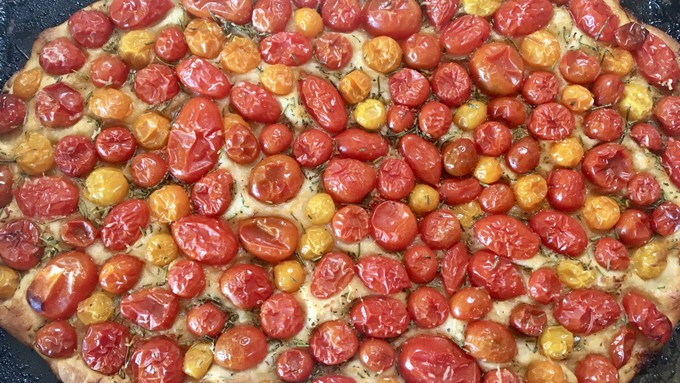
Find our recipes for summer's luscious produce all in one place

We have 15 tomato-centric recipes to share in Taste Summer! including this Cherry Tomato Focaccia. Kathy Morrison
Summer is such a glorious time for fresh produce. Tomatoes, of course, but also cucumbers, corn, peppers, zucchini. And the fruit! Peaches, nectarines and plums are just the start of summer's bounty.
Here at Sacramento Digs Gardening, we have published five summers of recipes, one each Sunday of the season, Debbie and Kathy alternating. Each recipe features something we've harvested from our own gardens, or found at the local farmers markets and farm stands. Each recipe is tested and proven in our own kitchens.
Those 60-plus recipes are now together in one place, debuting online in "Taste Summer!" It's our second e-cookbook, following the publication of Taste Spring! in April, and it's just in time for Fourth of July celebrations.
Because Sacramento summers can be so hot, many of our recipes are designed for minimal or no cooking. Chilled peach soup, anyone? We have two versions, including a vegan one. We have some cool cocktails, too.
Tomatoes, not surprisingly, account for 25 percent of the summer recipes, ranging from cherry tomato focaccia to tomato tart, tomato pilaf to tomato clafoutis. We have an easy slow-cooker sauce for now, and tomato jam and chutney to preserve for later. We even have a recipe to make tomato powder from the leftover skins: It's great sprinkled on salads or popcorn.
Summer produce works so well in both sweet and savory recipes. We put pluots in salad, cantaloupe in gazpacho and white nectarines in salsa. Squash gets into the act with Kathy's popular chocolate zucchini bread.
Then there are the delicious surprises: Baked cucumbers! Tomato crisp! Roasted grapes! Zapped pickles! (That one uses cukes or zukes.) Debbie also has an easy salsa verde that makes terrific use of fruit from a tomatillo plant on overdrive.
Whether you harvest your own fresh summer produce, or indulge at the farmers market, you'll find delicious and useful recipes for fruits and vegetables in Taste Summer!
Comments
0 comments have been posted.Sacramento Digs Gardening to your inbox.
Food in My Back Yard Series
May 6: Maintain soil moisture with mulch for garden success
April 29: What's (already) wrong with my tomato plants?
April 22: Should you stock up on fertilizer? (Yes!)
April 15: Grow culinary herbs in containers
April 8: When to plant summer vegetables
April 1: Don't be fooled by these garden myths
March 25: Fertilizer tips: How to 'feed' your vegetables for healthy growth
March 18: Time to give vegetable seedlings some more space
March 11: Ways to win the fight against weeds
March 4: Potatoes from the garden
Feb. 25: Plant a fruit tree now -- for later
Feb. 18: How to squeeze more food into less space
Feb. 11: When to plant? Consider staggering your transplants
Feb. 4: Starting in seed starting
Sites We Like
Garden Checklist for week of May 11
Make the most of the lower temperatures early in the week. We’ll be back in the 80s by Thursday.
* Plant, plant, plant! It’s prime planting season in the Sacramento area. Time to set out those tomato transplants along with peppers and eggplants. Pinch off any flowers on new transplants to make them concentrate on establishing roots instead of setting premature fruit.
* Direct-seed melons, cucumbers, summer squash, corn, radishes, pumpkins and annual herbs such as basil.
* Harvest cabbage, lettuce, peas and green onions.
* In the flower garden, direct-seed sunflowers, cosmos, salvia, zinnias, marigolds, celosia and asters. (You also can transplant seedlings for many of the same flowers.)
* Plant dahlia tubers.
* Transplant petunias, marigolds and perennial flowers such as astilbe, columbine, coneflowers, coreopsis, dahlias, rudbeckia and verbena.
* Keep an eye out for slugs, snails, earwigs and aphids that want to dine on tender new growth.
* Feed summer bloomers with a balanced fertilizer.
* For continued bloom, cut off spent flowers on roses as well as other flowering plants.
* Add mulch to the garden to maintain moisture. Mulch also cuts down on weeds. But don’t let it mound around the stems or trunks of trees or shrubs. Leave about a 6-inch-to-1-foot circle to avoid crown rot or other problems.
* Remember to weed! Pull those nasties before they set seed.
* Water early in the day and keep seedlings evenly moist.